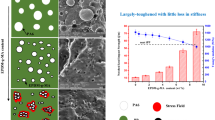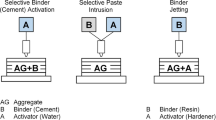Abstract
In the past years, the use of liquid additives as bitumen modifiers has increased to tailor the rheology of bitumen for a wide range of applications. Their chemical composition and mutual interaction result in specific phase morphologies in the binders. Hence, there is a need to evaluate the phase morphology of complex binders and the impact of additives on their physical properties. The RILEM Technical Committee 272-PIM ‘Phase and Interphase behaviour of innovative bituminous Materials’, Task Group TG1 assessed the phase and interphase properties of bituminous binders. Some preliminary results are presented on blends using three liquid additives and a neat 35/50 bitumen. The goal of formulating the blends was to achieve similar consistency of a pen grade 70/100 bitumen at the original state and to evaluate the binders at both original and after aging. Physical properties were evaluated through rheological characterisation using a dynamic shear rheometer (DSR) in a wide range of conditions. The phase morphology was assessed using atomic force microscopy (AFM). Differential scanning calorimetry (DSC) was also used for the characterisation of the thermal behaviour of the binders. While conventional properties, as obtained from the routine binder testing methods, hardly distinguish between blends, the cross-over temperature, derived from DSR measurements, enabled to dictate the impact of liquid additives on the physical properties of bituminous binders at intermediate temperature. AFM confirmed a difference in phase morphology between the blends, whereas some binders displayed new phases at original and aged conditions. Glass transition, as determined by DSC, also showed a difference in the low-temperature domain that may be explained with the difference in phase morphology. Overall, an in-depth understanding of microstructure morphology and glass transition behaviour of complex binders can assist in designing future specifications to distinguish durable bituminous materials better.






Similar content being viewed by others
References
Nahar SN, Teugels W, van de Wall A, Poeran N, van Vilsteren I (2021) Grip on Bitumen: mapping the changes in bitumen market and its impact on performance. In: 7th E&E Congress, Eurasphalt & Eurobitume
Grilli A, Iori L, Porot L (2019) Effect of bio-based additives on bitumen properties. Road Mater Pavement Des 20(8):1864–1879. https://doi.org/10.1080/14680629.2018.1474790
Koudelka T, Porot L, Coufalik P, Varaus M (2018) The use of rejuvenators as an effective way to restore aged binder properties. In: Proceedings of 7th Transport Research Arena TRA 2018, Vienna, Austria
Soenen H, Besamusca J, Poulikakos L, Planche JP, Das P, Kringos N, Grenfell J, Chailleux E, (2013) Differential scanning calorimetry applied to bitumen: results of the RILEM NBM TG1 Round Robin test, multi-scale modeling and characterization of infrastructure materials. RILEM Bookseries, vol 8. Springer: Dordrecht
Soenen H, Besamusca J, Fischer HR, Poulikakos LD, Planche JP, Das PK, Kringos N, Grenfell JRA, Lu X, Chailleux E (2014) Laboratory investigation of bitumen based on round Robin DSC and AFM tests. Mater Struct 47:1205–1220. https://doi.org/10.1617/s11527-013-0123-4
Porot L, Chailleux E, Apostolidis P, Zhu J, Margaritis A, Tsantili L (2020) Complex bituminous binders, are current test methods suitable for? In: Proceeding of RILEM international symposium on bituminous materials, Lyon, France
Holleran I, Masad E, Holleran G, Wubulikasimu Y, Malmstrom J, Wilson DJ (2021) Nanomechanical mapping of rejuvenated asphalt binders. Road Mater Pavement Des 22(11):2478–2497. https://doi.org/10.1080/14680629.2020.1771406
Asphalt Institute. (2015) State-of-the-Knowledge: The Use of REOB in Asphalt. IS 235
Porot L, Vansteenkiste S, Makowska M, Carbonneau X, Zhu J, Damen S, Plug K (2021) Characterisation of complex polymer modified Bitumen with rheology parameters. EATA. https://doi.org/10.1080/14680629.2021.1910070
Nahar SN, Mohajeri M, Schmets AJM, Scarpas A, van de Ven MFC, Schitter G (2013) First observation of blending-zone morphology at interface of reclaimed asphalt binder and virgin bitumen. Transp Res Record 2370:1–9. https://doi.org/10.3141/2370-01
Nahar SN, Qiu J, Schmets AJM, Schlangen E, Shirazi M, van de Ven MFC, Schitter G, Scarpas A (2014) Turning back time: rheological and microstructural assessment of rejuvenated bitumen. Transp Res Record 2444:52–62. https://doi.org/10.3141/2444-06
Nahar SN, Schmets AJM, Schitter G, Scarpas A (2016) Quantifying the thermomechanical response of bitumen from microphase properties. Transp Res Record 2574:101–110. https://doi.org/10.3141/2574-11
Jager A, Lackner R, Eisenmenger-Sittner C, Blab R (2004) Identification of four material phases in bitumen by atomic force microscopy. Road Mater Pavement Des 5(1):9–24. https://doi.org/10.1080/14680629.2004.9689985
Allen RG, Little DN, Bhasin A (2012) Structural characterization of micromechanical properties in asphalt using atomic force microscopy. J Mater Civ Eng 24(10):1317–27. https://doi.org/10.1061/(ASCE)MT.1943-5533.0000510
Pauli AT (2014), Chemomechanics of damage accumulation and damage-recovery healing in bituminous asphalt binders. PhD Thesis, Delft University of Technology
Nahar SN (2016) Phase-separation characteristics of bitumen and their relation to damage-healing. PhD Thesis, Delft University of Technology
Anderson DA, Marasteanu MO (1999) Physical hardening of asphalt binders relative to their glass transition temperatures. Transp Res Record 1661:27–34. https://doi.org/10.3141/1661-05
Elwardany M, Planche JP, King G (2020) Universal and practical approach to evaluate asphalt binder resistance to thermally-induced surface damage. Constr Build Mater 255:119331. https://doi.org/10.1016/j.conbuildmat.2020.119331
Apostolidis P, Elwardany M, Porot L, Vansteenkiste S, Chailleux E (2021) Glass transitions in bituminous binders. Mater Struct 54:132. https://doi.org/10.1617/s11527-021-01726-6
Anderson DA, Christensen DW, Bahia HU, Dongré RN, Sharma MG, Antle CE, Button J (1994) Binder characterization and evaluation (SHRP A-369). Vol. 3, physical characterization. Strategic Highway Research Program, National Research Council, Washington, D.C
Porot L, Eduard P, (2016) Addressing asphalt binder aging through the viscous to elastic transition. ISAP Symposium, JacksonHole, US
Cucalon LG, King G, Kaseer F, Arambula-Mercado E, Martin AE, Turner TF, Glover GJ (2017) Compatibility of recycled binder blends with recycling agents: rheological and physicochemical evaluation of rejuvenation and aging processes. Ind Eng Chem Res 56:8375–8384. https://doi.org/10.1021/acs.iecr.7b01657
Schmets A, Kringos N, Pauli T, Redelius P, Scarpas T (2010) On the existence of wax-induced phase separation in bitumen. Int J Pavement Eng 11(6):555–563. https://doi.org/10.1080/10298436.2010.488730
Pauli AT, Grimes RW, Beemer AG, Turner TF, Branthaver JF (2011) Morphology of asphalts, asphalt fractions and model wax-doped asphalts studied by atomic force microscopy. Int J Pavement Eng 12(4):291–309. https://doi.org/10.1080/10298436.2011.575942
Acknowledgements
The authors acknowledge RILEM TC 272 PIM – TG1 ‘Phase and interphase behaviour of innovative bituminous materials’ for providing the materials and valuable discussions. This article was prepared by a task group within RILEM TC 272-PIM: Phase and Interphase behaviour of bituminous Materials. The article has been reviewed and approved by all members of the TG and the TC.
Author information
Authors and Affiliations
Corresponding author
Ethics declarations
Conflict of interest
The authors declare that they have no conflict of interest.
Additional information
Publisher's Note
Springer Nature remains neutral with regard to jurisdictional claims in published maps and institutional affiliations.
TC Membership
Chair: Emmanuel Chailleux (Université Gustave Eiffel, France), emmanuel.chailleux@ifsttar.fr
Deputy Chair: Christiane Raab (EMPA), christiane.raab@empa.ch
TC Membership. Chair: Emmanuel Chailleux (Université Gustave Eiffel, France); Deputy Chair: Christiane Raab (EMPA, Switzerland); TC Members: Panos APOSTOLIDIS, TU Delft, The Netherlands; Francesco CANESTRARI, Università Politecnica delle Marche, Italy ; Augusto CANNONE-FALCHETTO, Aalto University, Finland; Xavier CARBONNEAU, COLAS, France; Alan CARTER, ETS Montréal, Canada ; Emmanuel CHAILLEUX, Université Gustave Eiffel, France ; Davide DALMAZZO, Politecnico di Torino, Italy; Hervé DI BENEDETTO, ENTPE, France; Michael ELWARDANY, Florida state university, United States; Andrea GRAZIANI, Università Politecnica delle Marche, Italy ; Hamzeh HAGHSHENAS, Federal Highway Administration, United States; Bernhard HOFKO, University of Technology Vienna, Austria; Mariusz JACZEWSKI, Gdansk University of Technology, Poland; Piotr JASKULA, Gdansk University of Technology, Poland; Salvatore MANGIAFICO, ENTPE, France; Alexandros MARGARITIS, Belgian Road Research Centre, Belgium; Virginie MOUILLET, CEREMA DTER MED, France; Sayeda NAHAR, TNO, The Netherlands; Jorge Carvalho PAIS, University of Minho, Portugal; Daniel PERRATON, ETS Montreal, Canada ; Christophe PETIT, Univerity of Limoges, France ; Kees PLUG, Ooms Civiel bv, The Netherlands; Laurent POROT, Kraton Polymers B.V., The Netherlands; Simon POUGET, Eiffage infrastructures, France ; Lily POULIKAKOS, EMPA, Switzerland; Marek PSZCZOLA, Gdansk University of Technology, Poland; Christiane RAAB, EMPA, Switzerland; Dawid RYS, Gdansk University of Technology, Poland; Cesare SANGIORGI, University of Bologna, Italy; Cédric SAUZEAT, ENTPE, France; Hilde SOENEN, Nynas, Belgium; Daniel STEINER, Austrian Quality Assurance Association for Aggregates, Austria; Lucia TSANTILIS, Politecnico di Torino, Italy; Stefan VANSTEENKISTE, Centre de Recherches Routières, Belgium ; Di WANG, Aalto University, Finland; Michael P. WISTUBA, Tehnical Univerity of Braunschweig, Germany; Martins ZAUMANIS, EMPA, Switzerland; Jiqing ZHU, Swedish National Road and Transport Research Institute (VTI), Sweden; Adam M. ZOFKA, IBDiM, Poland.
Rights and permissions
About this article
Cite this article
Nahar, S., Porot, L. & Apostolidis, P. RILEM TC272 PIM: phase morphology of bituminous binders with liquid additives. Mater Struct 55, 239 (2022). https://doi.org/10.1617/s11527-022-02068-7
Received:
Accepted:
Published:
DOI: https://doi.org/10.1617/s11527-022-02068-7




